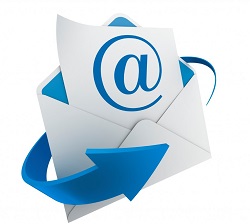
E-Mail Settings
Last updated 23rd April 2018
*
Judged the
Best PC & Laptop Repair Company 2021 - Devon
Setting up your email client for the first time can seem a
little complicated, but once you know the basics, you can get
yourself up and running in no time. If you would prefer me
to do it for you, please contact me.
Your email provider is known as a "Host" and they keep their information on computer(s) known as server(s).
An email application on your computer is known as a
"client", and while each one is
different, they all have a lot in common. They all need the same
key information to send and receive emails properly. You need to
choose which setting protocol you want to use (IMAP or POP3),
and you need to decide on some configuration settings. I'll
explain all of these in a moment.
| IMAP | POP3 |
| If you use IMAP, your email client syncs with the email server. This means that whenever you make any changes to your mailbox, those changes will be visible on every device, email client and webmail service you use. Your mailbox is backed up automatically on the server. | If you use POP3, your email client doesn't sync with the server. So when you make any mailbox changes, those changes won't be shown across all devices. POP3 works best when you intend only using a single device. |
Which should I use?
I recommend…
That you use IMAP. That way, if anything goes wrong with your email client you'll still be able to access your emails using another client, or via a webmail service.
Scroll down to find your email provider and see how to set up your email client correctly.......
1and1 Hosted domains
| IMAP (Recommended) | POP3 | |
| Incoming | imap.1and1.co.uk | pop.1and1.co.uk |
| Outgoing | auth.smtp.1and1.co.uk | auth.smtp.1and1.co.uk |
| Username | Your 1and1 email Address | Your 1and1 email Address |
| Password | Your 1and1 email Password | Your 1and1 email Password |
| Authentication | No | No |
| Outgoing Authentication | Yes | Yes |
| Incoming Port | 993 | 995 |
| Encryption | SSL | SSL |
| Outgoing Port | 587 | 587 |
| Encryption | TLS | TLS |
@btinternet.com
| IMAP (Recommended) | POP3 | |
| Incoming | mail.btinternet.com | mail.btinternet.com |
| Outgoing | mail.btinternet.com | mail.btinternet.com |
| Username | Your BT email Address | Your BT email Address |
| Password | Your BT email Password | Your BT email Password |
| Authentication | No | No |
| Outgoing Authentication | Yes | Yes |
| Incoming Port | 993 | 995 |
| Encryption | SSL | SSL |
| Outgoing Port | 465 | 465 |
| Encryption | SSL | SSL |
@gmail.com
| IMAP (Recommended) | POP3 | |
| Incoming | imap.gmail.com | pop.gmail.com |
| Outgoing | smtp.gmail.com | smtp.gmail.com |
| Username | Your Gmail email Address | Your Gmail email Address |
| Password | Your Gmail email Password | Your Gmail email Password |
| Authentication | Yes | Yes |
| Outgoing Authentication | Yes | Yes |
| Incoming Port | 993 | 995 |
| Encryption | SSL | SSL |
| Outgoing Port | 587 | 587 |
| Encryption | TLS | TLS |
| Notes: | Enable IMAP | Enable POP3 |
| For Outlook Allow Less Secure Apps | For Outlook Allow Less Secure Apps |
@hotmail.com
| IMAP (Recommended) | POP3 | |
| Incoming | imap-mail.outlook.com | pop-mail.outlook.com |
| Outgoing | smtp-mail.outlook.com | smtp-mail.outlook.com |
| Username | Your Hotmail email Address | Your Hotmail email Address |
| Password | Your Hotmail email Password | Your Hotmail email Password |
| Authentication | No | No |
| Outgoing Authentication | Yes | Yes |
| Incoming Port | 993 | 995 |
| Encryption | SSL | SSL |
| Outgoing Port | 587 | 587 |
| Encryption | TLS | TLS |
| Notes: | POP access must be turned on via web
interface. In the web interface click “gear icon” in the top, right corner, then select “Options”. Depending on the UI version: On the options pane click “Mail/Accounts/POP and IMAP”. In the “POP options” section select “Yes”. -or- On the options pane click “Connect devices and apps with POP” link. In the “POP” section mark “Enable”. |
|
@outlook.com
| IMAP (Recommended) | POP3 | |
| Incoming | imap.gmail.com | pop.gmail.com |
| Outgoing | smtp.gmail.com | smtp.gmail.com |
| Username | Your Gmail email Address | Your Gmail email Address |
| Password | Your Gmail email Password | Your Gmail email Password |
| Authentication | No | No |
| Outgoing Authentication | Yes | Yes |
| Incoming Port | 993 | 995 |
| Encryption | SSL | SSL |
| Outgoing Port | 587 | 587 |
| Encryption | TLS | TLS |
@plus.net same settings for @force9.net, @free-online.net (See notes below)
| IMAP (Recommended) | POP3 | |
| Incoming | imap.plus.net | pop.plus.net |
| Outgoing | relay.plus.net | relay.plus.net |
| Username | Your Plus.net account name | Your Plus.net account name |
| Password | Your Plus.net email Password | Your Plus.net email Password |
| Authentication | No | No |
| Outgoing Authentication | Yes | Yes |
| Incoming Port | 993 | 995 |
| Encryption | SSL | SSL |
| Outgoing Port | 587 (recommended) or 25 | 587 (recommended) or 25 |
| Encryption | STARTTLS or SSL/TLS | STARTTLS or SSL/TLS |
| Notes: | Substitute force9.net or free-online.net for plus.net | Substitute force9.net or free-online.net for plus.net |
| if applicable. | if applicable. | |
| Plus.net do not have a secure email server so you may need to agree to proceed without it. | Plus.net do not have a secure email server so you may need to agree to proceed without it. |
@sky.com
| IMAP (Recommended) | POP3 | |
| Incoming | imap.tools.sky.com | pop.tools.sky.com |
| Outgoing | smtp.tools.sky.com | smtp.tools.sky.com |
| Username | Your Sky email Address | Your Sky email Address |
| Password | Your Sky email Password | Your Sky email Password |
| Authentication | No | No |
| Outgoing Authentication | Yes | Yes |
| Incoming Port | 993 | 995 |
| Encryption | SSL | SSL |
| Outgoing Port | 465 | 465 |
| Encryption | SSL | SSL |
@talktalk.net
| IMAP (Recommended) | POP3 | |
| Incoming | mail.talktalk.net | mail.talktalk.net |
| Outgoing | smtp.talktalk.net | smtp.talktalk.net |
| Username | Your Talktalk email Address | Your Talktalk email Address |
| Password | Your Talktalk email Password | Your Talktalk email Password |
| Authentication | No | No |
| Outgoing Authentication | Yes | Yes |
| Incoming Port | 993 | 995 |
| Encryption | SSL | SSL |
| Outgoing Port | 587 | 587 |
| Encryption | TLS (STARTTLS) | TLS (STARTTLS) |
@tiscali.co.uk
| IMAP (Recommended) | POP3 | |
| Incoming | imap.tiscali.co.uk | pop.tiscali.co.uk |
| Outgoing | smtp.tiscali.co.uk | smtp.tiscali.co.uk |
| Username | Your Tiscali email Address | Your Tiscali email Address |
| Password | Your Tiscali email Password | Your Tiscali email Password |
| Authentication | No | No |
| Outgoing Authentication | Yes | Yes |
| Incoming Port | 993 | 995 |
| Encryption | SSL | SSL |
| Outgoing Port | 587 | 587 |
| Encryption | SSL | SSL |
@virginmedia.com, same settings for @virgin.net, @blueyonder.co.uk, @ntlworld.com
| IMAP (Recommended) | POP3 | |
| Incoming | imap.virginmedia.com | pop3.virginmedia.com |
| Outgoing | smtp.virginmedia.com | smtp.virginmedia.com |
| Username | Your email Address | Your email Address |
| Password | Your email Password | Your email Password |
| Authentication | Yes | Yes |
| Outgoing Authentication | Yes | Yes |
| Incoming Port | 993 | 995 |
| Encryption | SSL | SSL |
| Outgoing Port | 465 | 465 |
| Encryption | SSL | SSL |
| Notes: | Enable IMAP | Enable POP3 |
| For Outlook Allow Less Secure Apps | For Outlook Allow Less Secure Apps |
@yahoo.com
| IMAP (Recommended) | POP3 | |
| Incoming | imap.mail.yahoo.com | pop.mail.yahoo.com |
| Outgoing | smtp.mail.yahoo.com | smtp.mail.yahoo.com |
| Username | Your Yahoo email Address | Your Yahoo email Address |
| Password | Your Yahoo email Password | Your Yahoo email Password |
| Authentication | Yes | Yes |
| Outgoing Authentication | Yes | Yes |
| Incoming Port | 993 | 995 |
| Encryption | SSL | SSL |
| Outgoing Port | 465 or 587 | 465 or 587 |
| Encryption | SSL | SSL or TLS |

